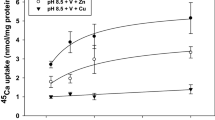Summary
In order to investigate whether the loop diuretic sensitive, sodium-chloride cotransport system described previously in shark rectal gland is in fact a sodium-potassium chloride cotransport system, plasma membrane vesicles were isolated from rectal glands ofSqualus acanthias and sodium and rubidium uptake were measured by a rapid filtration technique. In addition, the binding of N-methylfurosemide to the membranes was investigated. Sodium uptake into the vesicles in the presence of a 170mm KCl gradient was initially about five-fold higher than in the presence of a 170mm KNO3 gradient. In the presence of chloride, sodium uptake was inhibited 56% by 0.4mm bumetanide and 40% by 0.8mm N-methylfurosemide. When potassium chloride was replaced by choline chloride or lithium chloride, sodium uptake decreased to the values observed in the presence of potassium nitrate. Replacement of potassium chloride by rubidium chloride, however, did not change sodium uptake. Initial rubidium uptake into the membrane vesicles was about 2.5-fold higher in the presence of a 170mm NaCl gradient than in the presence of a 170mm NaNO3 gradient. The effect of chloride was completely abolished by 0.4mm bumetanide. Replacement of the sodium chloride gradient by a lithium chloride gradient decreased rubidium uptake by about 40%; replacement by a choline chloride gradient reduced the uptake even further. Rubidium uptake was also strongly inhibited by potassium. Sodium chloride dependence and bumetanide inhibition of rubidium flux were also found in tracer exchange experiments in the absence of salt gradients. The isolated plasma membranes bound3[H]-N-methylfurosemide in a dose-dependent manner. In Scatchard plots, one saturable component could be detected with an apparentK D of 3.5×10−6 m and a number of sitesn of 104 pmol/mg protein. At 0.8 μm, N-methylfurosemide binding decreased 51% when sodium-free or low-potassium media were used. The same decrease was observed when the chloride concentration was increased from 200 to 600mm or when 1mm bumetanide or furosemide were added to the incubation medium. These studies indicate that the sodium-chloride cotransport system described previously in the rectal gland is in fact a sodium-potassium chloride cotransport system. It is postulated that this transport system plays an essential role in the secondary active chloride secretion of the rectal gland.
Similar content being viewed by others
References
Burger, J.W., Hess, W.N. 1960. Function of the rectal gland in spiny dogfish.Science 131:670–671
Chipperfeld, A.R. 1980. An effect of chloride on (Na+K) cotransport in human red blood cells.Nature (London) 286:281–282
Eveloff, J., Kinne, R., Kinne-Saffran, E., Murer, H., Silva, P., Epstein, F.H., Stoff, J., Kinter, W.B. 1978. Coupled sodium and chloride transport into plasma membrane vesicles prepared from dogfish rectal gland.Pfluegers Arch. 378:87–92
Forbush, B., Palfrey, H.C. 1982. Bumetanide and benzmetanide binding to membranes from shark rectal gland and canine kidney.Biophys. J. 37:161a
Geck, P., Pietrzyk, C., Burckhardt, B.C., Pfeiffer, B., Heinz, E. 1980. Electrically silent cotransport of Na+, K+, and Cl− in Ehrlich cells.Biochim. Biophys. Acta 600:432–447
Hokin, L.E., Dahl, J.L., Deupree, J.D., Dixon, J.F., Hackney, J.F., Perdue, F. 1973. Studies on the characterization of the sodium-potassium transport adenosine triphosphatase.J. Biol. Chem. 248:2593–2605
Joergensen, P.L. 1980. Sodium and potassium ion pump in kidney tubules.Physiol. Rev. 60:864–917
Kinne, R. 1976. Properties of the glucose transport system in renal brush border membrane.Curr. Top. Memb. Trans. F. Bronner and A. Kleinzeller, editors. pp. 209–267. Academic Press, New York
Kinne, R., Kinne-Saffran, E. 1979. Effect of loop diuretics on the salt secretion in shark rectal gland.Mar. Ecol. 1:129–132
Kinne, R., Kinne-Saffran, E., Epstein, J., Silva, P., Epstein, F.H., Miller, D., Eveloff, J. 1979. Effect of “loop diuretics” on sodium transport by plasma membrane vesicles isolated from rectal gland ofSqualus acanthias.Bull. Mt. Desert Isl. Biol. Lab. 19:92–95
Kinne, R., Schmitz, J.E., Kinne-Saffran, E. 1971. The localization of Na−K-ATPase in the cells of rat kidney cortex. A study on isolated plasma membranes.Pfluegers Arch. 329:191–206
Kinsella, J.L., Aronson, P.S. 1980. Properties of the Na+−H+ exchanger in renal microvillus membrane vesicles.Am. J. Physiol. 238:F461-F469
Koenig, B., Ricapito, S., Kinne, R. 1983. Na−K−Cl cotransport in plasma membrane vesicles isolated from thick ascending limb of Henle's loop.Pluegers Arch. (submitted)
Lowry, O.H., Rosebrough, N.J., Farr, A.L., Randall, R.J. 1951. Protein measurement with the Folin phenol reagent.J. Biol. Chem. 193:265–275
McRoberts, J.A., Erlinger, S., Rindler, M.J., Saier, M.H. 1982. Furosemide sensitive salt transport in Madin-Darby canine kidney cell line. Evidence for cotransport of Na, K, and Cl.J. Biol. Chem. 257:2260–2266
Musch, M., Field, M., Frizzell, R.A. 1981. Active K+ transport by the intestine of the flounderPleuronectes americanus: Evidence for cotransport with Na and Cl.Bull. Mt. Desert Isl. Biol. Lab. 21:95–99
Palfrey, H.C., Feit, P.W., Greengard, P. 1980. cAMP stimulated cation cotransport in avian erythrocytes: Inhibition by “loop” diuretics.Am. J. Physiol. 238:C139-C148
Palfrey, H.C., Silva, P., Epstein, F.H. 1980. Effects of ethacrynic acid and related compounds on active Cl secretion by the dogfish rectal gland.Bull. Mt. Desert Is. Biol. Lab. 20:34–36
Silva, P., Epstein, J., Myers, M., Stevens, A., Epstein, F.H. 1981. Inhibition of chloride secretion by BaCl2 in the rectal gland of the spiny dogfishSqualus acanthias.Bull. Mt. Desert Isl. Biol. Lab. 21:12–13
Silva, P., Stoff, J., Field, M., Fine, L., Forrest, J.N., Epstein, F.H. 1977. Mechanism of active chloride secretion by shark rectal gland: Role of Na−K-ATPase.Am. J. Physiol. 233:F298-F306
Author information
Authors and Affiliations
Rights and permissions
About this article
Cite this article
Hannafin, J., Kinne-Saffran, E., Friedman, D. et al. Presence of a sodium-potassium chloride cotransport system in the rectal gland ofSqualus acanthias . J. Membrain Biol. 75, 73–83 (1983). https://doi.org/10.1007/BF01870801
Received:
Revised:
Issue Date:
DOI: https://doi.org/10.1007/BF01870801




